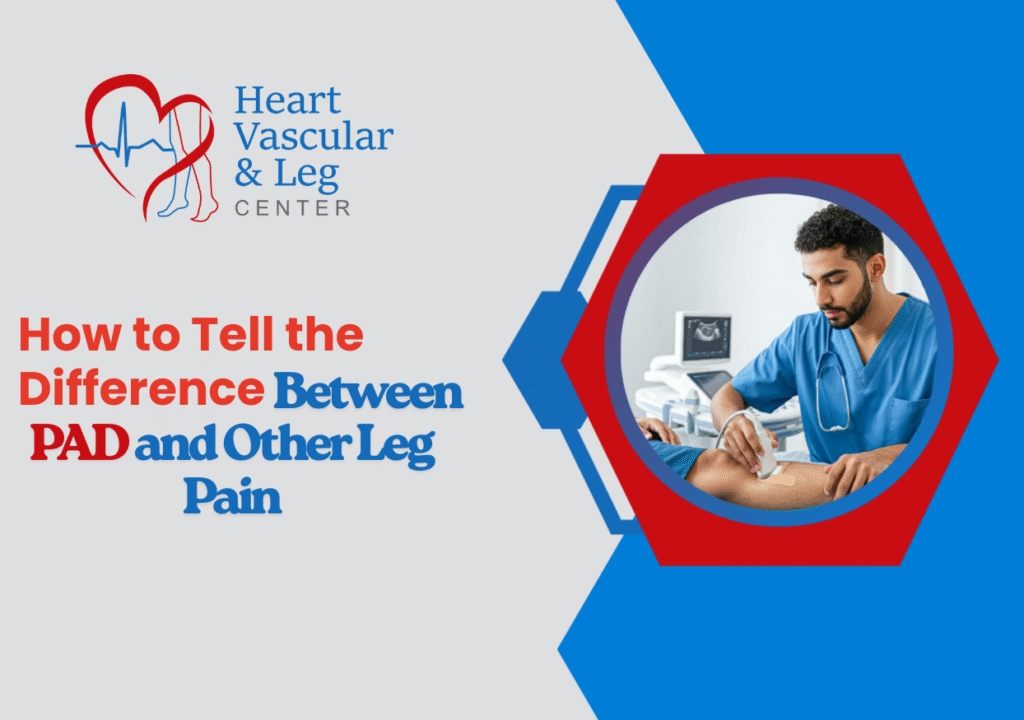
One day you’re fine walking, and the next day, you’re met with aches, cramps, or sharp pain every step of the way.
Here’s the thing: all leg pain is not created equal, and knowing what you’re dealing with makes all the difference in getting the right treatment.
Leg pain caused by Peripheral Arterial Disease (PAD) is characterized by a specific etiology that differentiates it from other types of leg pain.
And the biggest clue is all to do with blood flow: narrowed or blocked, arteries fail to allow enough oxygen-rich blood through leg muscles during activity.
This is typically associated with PAD pain and known as claudication.
When you walk or climb stairs, you will experience cramping, aching, or fatigue in your calf, thigh, or buttock muscles.
Normally, the pain will start after walking the same distance on every occasion, maybe half a block or a flight of stairs.
After you sit down for a few minutes, it vanishes completely.
This stop-and-go pattern is PAD’s trademark. Your muscles ask for more oxygen but can’t get from narrowed arteries.
Muscle Strains and Overuse
Unlike PAD, muscle strain pain is generally due to overexertion at the gym or in the yard. This pain will be sharp or throbbing and will not go away with rest.
You are likely to remember the particular moment or activity that caused it.
Nerve Issues (Sciatica)
Neuropathy body aches are usually vague and hard to pin down to one location. They often feel “off” instead of acutely painful.
Some numbness and tingling can always be felt in your leg, regardless of whether you’re moving or sitting; this is opposed to the muscle-focused, activity-triggered pain from PAD.
Varicose Veins
Leg discomfort may be described as heavy or achy, usually increasing later in the day.
Reasonably identifiable are visible bulging veins, with the pain not directly proportional to the activity level or walking.
You might have pain, but certain things make it more likely to be PAD compared with other things:
There are those leg pain situations that should never miss immediate attention.
If, for instance, one experiences sudden and severe leg pain with coldness and numbness, or if non-healing sores develop on the feet or legs, then one should never wait.
There could be a great signal of severe circulation problems that need immediate treatment.
The possible intervention is critical for PAD and other related systemic vascular insufficiencies.
Preventing amputation through early treatment can save limbs and improve quality of life dramatically.
Getting the Right Diagnosis
The good news is that PAD is indeed a highly treatable condition, provided it is caught in its early stages.
We specialize in diagnosing and treating PAD at the Heart Vascular and Leg Center.
Our experienced team uses the latest techniques to get you back to the pain-free activities you love.
Contact the Heart Vascular and Leg Center now to book an appointment.
Can PAD pain happen at rest?
In advanced cases, yes. Rest pain typically occurs at night and may improve when hanging your leg over the bed’s edge.
Is PAD pain always in the calf?
No. Depending on where arteries are blocked, you might feel pain in your thigh, buttock, or foot instead.
Does PAD affect both legs equally?
Hardly ever. One leg is typically more subject to PAD than the other, especially in its early stages.
© Copyright 2024 Vascular Health Partners LLC. All Rights Reserved
Designed By CyberWorx